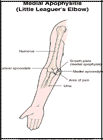
Medial Apophysitis (Little Leaguer's Elbow)
What is medial apophysitis (Little Leaguer's elbow)?
Little Leaguer's elbow is pain on the side of the elbow that is closest to the body.
The elbow joint is made up of the bone in the upper arm (humerus) and one of the bones in the lower arm (ulna). The bony bumps at the end of the humerus are called epicondyles. The bump closest to the body is called the medial epicondyle, and the bump on the outer side of the elbow is called the lateral epicondyle.
The muscles that work to bend the wrist attach at the medial epicondyle, and the muscles that work to straighten the wrist attach at the lateral epicondyle. Too much bending of the wrist will irritate the muscles that attach to the medial epicondyle.
In a child, the bones grow from areas called growth plates. There is a growth plate at the medial epicondyle called the medial apophysis. In Little Leaguer's elbow this growth plate is irritated or inflamed.
How does it occur?
Little Leaguer's elbow is caused by too much throwing. Too much throwing puts stress on the muscles that bend the wrist where they attach to the inner side of the elbow. The growth plate becomes inflamed. In severe cases, the growth plate may actually break way from the upper arm.
What are the symptoms?
Little Leaguer's elbow causes pain at the inner side of the elbow. There may be swelling and tenderness.
How is it diagnosed?
Your health care provider will examine your child's arm and elbow. There will be tenderness along the medial epicondyle. Your child will feel pain when he or she throws a ball for the provider. X-rays may show irritation or a break in the growth plate.
How is it treated?
The most important treatment for Little Leaguer's elbow is to not throw if the growth plate is inflamed. Ice packs should be placed on the elbow for 20 to 30 minutes every 3 to 4 hours for 2 to 3 days or until the pain goes away. An elastic elbow wrap may be placed on the inflamed elbow to give it more support. The health care provider may give your child an anti-inflammatory medication. Your child will be given rehabilitation exercises. In severe cases of Little Leaguer's elbow where there is a break in the bone, surgery may be needed.
When can my child return to his or her sport or activity?
The goal of rehabilitation is to return your child to his or her sport or activity as soon as is safely possible. If your child returns too soon the injury may be worsened, which could lead to permanent damage. Everyone recovers from injury at a different rate. Return to your child's sport or activity will be determined by how soon the elbow recovers, not by how many days or weeks it has been since your child's injury occurred. In general, the longer your child has symptoms before starting treatment, the longer it takes to get better.
Your child may begin throwing when there is no swelling around the injured elbow and it has regained its normal strength compared to the uninjured elbow. Your child must have full range of motion of the elbow. Throwing should be gradually increased but stopped if the elbow becomes painful.
How can Little Leaguer's elbow be prevented?
The best way to prevent Little Leaguer's elbow is to limit the amount of throwing a child does. Since this problem occurs the most in pitchers, there are guidelines for how many pitches or innings a child can throw in a week. In general, a child ages 9 through 12 years old should pitch a maximum of 6 innings per week (and no more than 250 pitches). A youngster ages 13 through 15 should pitch a maximum of 9 innings per week (and no more than 350 pitches).

